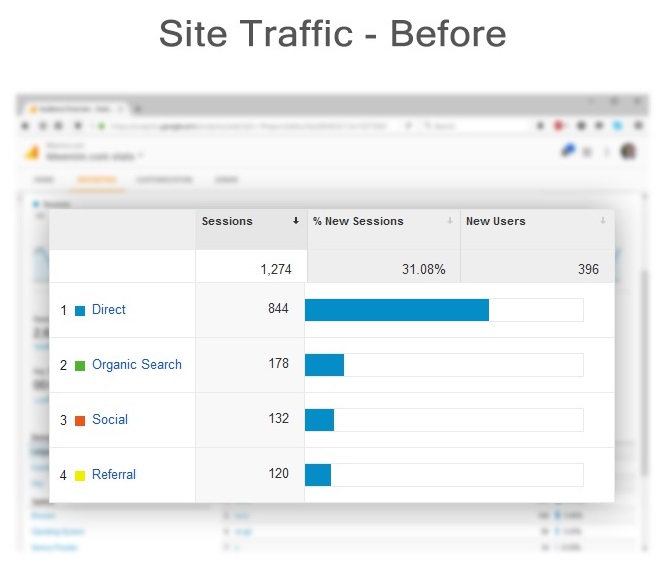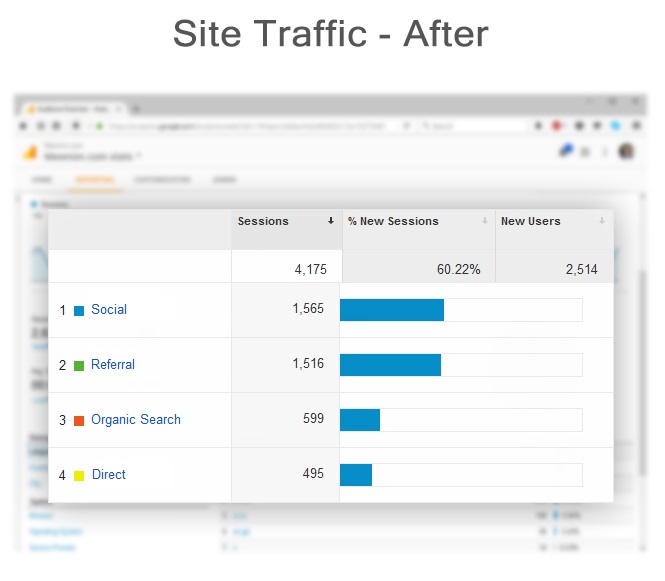If you don’t see the value of social media in your personal life, it is very easy to disregard how it applies to or can benefit your company. Admittedly, being focused on doing the “real thing,” I viewed personal use of social media as a pointless time waster. Not surprisingly, I didn’t consider investing much in social media in the early stages of my company. Our focus was on making the product better and chasing traditional leads.
Realizing the mistake
Our website traffic was dismal – we averaged only 50 users a day. Traffic stats revealed that most of our visitors came directly to the site. Those who learned about us through our hustling came to check the system out. But it was a very small audience, and we weren’t reaching potential clients effectively. We needed to build awareness about our product in order to direct more traffic to our website.
A bit of research led us back to our neglected social media efforts, and a compelling case was made for expanding our investment in social networking.
Fixing the problem
The first challenge we faced, as I mentioned earlier, was that our company wasn’t started by social media experts. Basically, we realized we had a problem, but we didn’t know exactly how to fix it. This meant we had to do some experimenting. We tried a few social media approaches, but we didn’t see any significant impact from them.
The “aha” moment came for us when we made a new hire. Our new team member was a younger university grad who lived and breathed social media. Now that we had someone on the team with the time, passion and experience to make progress, we developed a much more systematic approach. In three months of laboring on the social media initiative, here are the results.
Lessons learned
Lesson 1. Don’t be afraid to let someone who understands the subject better than you address missing skills in your startup.
Lesson 2. Social media takes time. It took us three months before we started seeing major results, so don’t get discouraged if your efforts don’t bring overnight results.
Pivot: How we got there
Our strategy finally began delivering the results. Here’s how we got to where we are:
Step 1. Prioritize who to connect with
Just like in business in general, if you try to be everything to everyone in social media, you’re setting yourself up for lacklustre outcomes, stress, and disappointment. You don’t need to connect with everyone; you just need to connect with the right people. Figure out ages and other demographics, motivations, and needs for your target audience. Defining your specific audience and setting priorities for who to contact helps you be more effective without getting overwhelmed. Continue to refine your target as you go along.
Step 2. Find where they “live”
Now that you’ve identified who you want to connect with, you need to follow them to their main social media outlets. Different demographic groups prefer different social media platforms. Furthermore, each platform tends to serve different purposes – greater engagement, brand awareness, site traffic, conversions, etc. – better than the other platforms do.
Social media channels have statistics on their users, which is a good first step in your research. Look into Facebook, Twitter, Instagram, Snapchat, Pinterest, and other channels. Find where your audience is and where they talk about products like yours — that is where you want to be. It doesn’t matter how amazing your Snapchat stories are if your prospective clients aren’t there to see them.
Step 3. Set your initial scope small
Every new social media channel you adopt is one more to maintain. It is easy to get drawn into every trendy social media outlet that makes the news, but one or two well maintained profiles are worth far more than five or six poorly monitored ones. We started with only two social media channels and invested all of our time and effort in growing them.
The first platforms we’ve invested in were Twitter and LinkedIn. We didn’t look at any other channels until we had established our footing on both with regular daily posting that resonated with our audience. Once we had that in hand, we expanded our reach to Instagram, as it is a very good fit with our product for the long term.
Step 4. Develop a process for each medium
Each medium requires a different approach. Take the time to develop a checklist for each social media outlet. This will require you to do some testing and establish optimum posting times, content guidelines, frequency, and posting steps. Once you have the checklist, follow it.
Step 5. Get tools to help
You don’t need to reinvent the wheel, and you also don’t need to invest in expensive tools. Don’t bite off more than you can chew until you know what you are doing. There are a lot of reasonably priced tools that can make it easier to manage your social media. A few of them are:
Step 6: Follow your strategy
Success in social media takes time and perseverance. We didn’t succeed overnight, it took us a month of steady work before we started to see our early results. The noticeable changes in website traffic didn’t happen until the third month.
The outcome
Our website traffic now is five times higher than it was before we started our social media efforts. Even more impressive is the fact that now traffic from social media sources exceeds direct traffic.
[A version of this post originally appeared on the Meemim blog.]
Alec Pestov is founder and CEO of collaborative software startup Meemim.
VentureBeat's mission is to be a digital town square for technical decision-makers to gain knowledge about transformative enterprise technology and transact. Learn More



